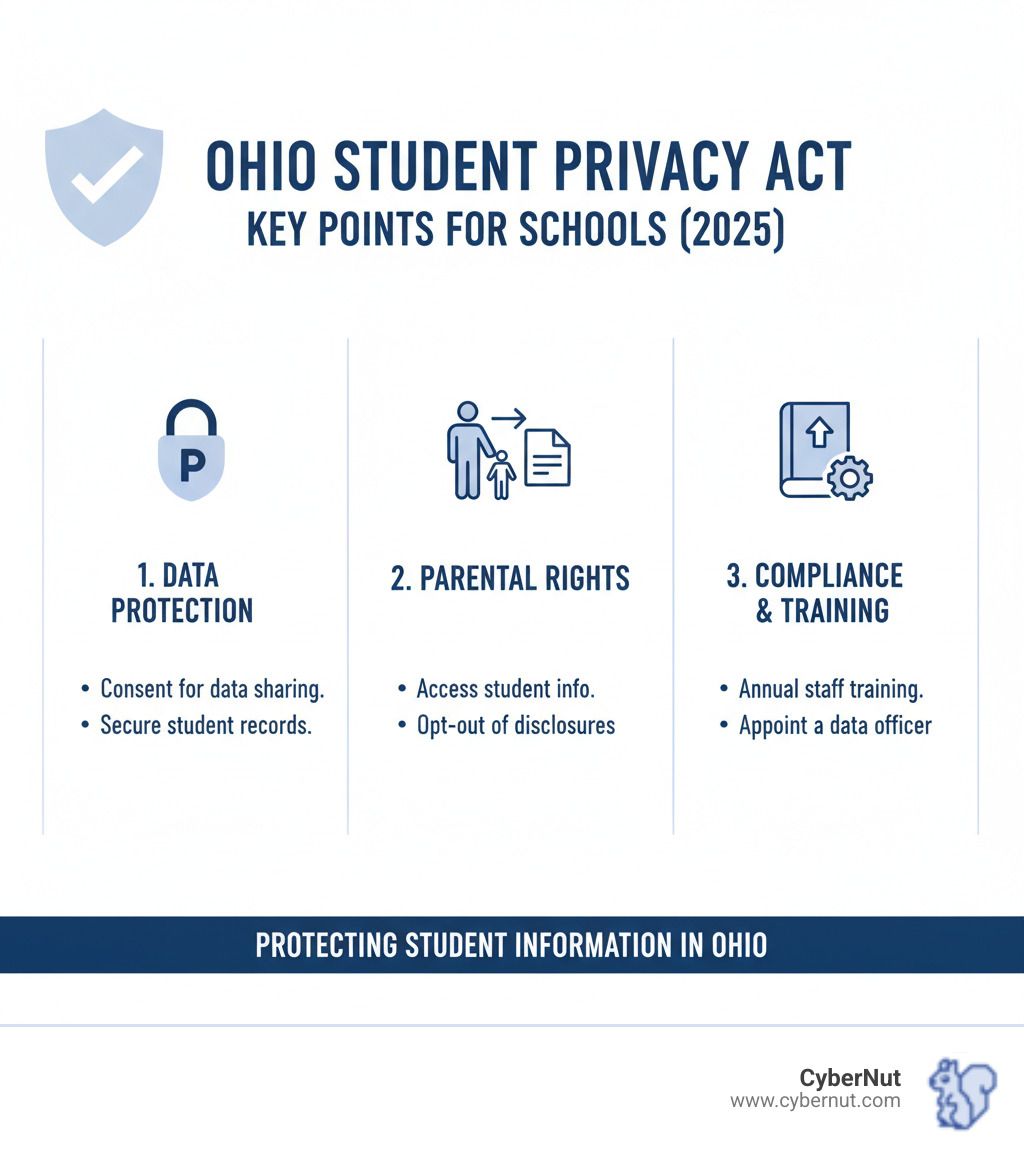
Oliver Page
Case study
October 8, 2025

What Ohio Schools Should Know About the Ohio Student Privacy Act starts with this: Ohio Senate Bill 29 (SB 29) took effect on October 24, 2024, bringing sweeping changes to how schools handle student data. For K-12 IT directors in Ohio, understanding these new requirements is urgent, as compliance deadlines are already here.
Here's what you need to know right away:
The new rules create administrative burdens, but they are critical. Citizens cannot opt out of giving public institutions their most private information. When this data is exposed, as it was in the devastating Minneapolis Public Schools ransomware attack, it shatters trust and violates the law.
The human element remains your biggest vulnerability. With cyber-attacks on the public sector up 40% in Q2 2023 and social engineering causing 70-90% of breaches, staff awareness is as critical as your contracts.
Want to know if your district is vulnerable? Get a Phishing Audit to see where your staff stands before a real attack tests them.

What Ohio Schools Should Know About the Ohio Student Privacy Act word roundup:
What Ohio Schools Should Know About the Ohio Student Privacy Act is that Senate Bill 29 is a fundamental shift in how Ohio protects student information. The law, effective October 24, 2024, has three core missions: improve student privacy, regulate technology partners, and ensure parents are informed about their children's data. SB 29 draws a protective circle around student data, with strict rules on access, use, and notification, specifically targeting tech contracts and device monitoring. For IT directors and administrators, this means student data privacy is no longer optional – it's law.
SB 29 regulates Ohio public schools and their technology partners – any entity that contracts with a school to provide devices or handle educational records. This includes LMS vendors, device manufacturers, and software providers. These partners now have direct legal obligations. School administrators and staff are also covered, as the State Board of Education can take action against an educator's license for misusing confidential student information.
Understanding what constitutes an educational record is essential. Under SB 29, these are records containing information directly related to a student and maintained by the school, including grades, attendance, disciplinary actions, and health information. However, a teacher's sole-possession records, certain employee records, and specific medical records for students 18+ are excluded.
This differs from directory information – basic data like names, addresses, and sports participation. Educational records require explicit consent for disclosure, while directory information can be released after parents are given a chance to opt out. Importantly, Ohio law prohibits releasing directory information for profit-making activities. This distinction is crucial for data handling, contracts, and parent notifications. To learn more, see our guide on Sensitive Data Definition and Types.
Most breaches happen due to human error, not sophisticated hacks. Request a Phishing Audit to see how prepared your staff is.

SB 29 mandates significant changes to technology contracts and device management.
Your contracts with technology providers now require specific, non-negotiable protections.
These requirements mean most existing contracts will need review and renegotiation, a significant but necessary administrative lift.
SB 29 also draws clear lines around monitoring school-issued devices. Generally, schools are prohibited from electronically monitoring location-tracking features, audio/visual recording, or student interactions on these devices.
However, there are key exceptions:
This creates a balance between privacy and safety. For help building a strategy, see our insights on creating a Data Security and Privacy Plan.
Transparency is enforced through three notification requirements:
These requirements demand robust systems to build and maintain trust with your community. Get a Phishing Audit to ensure your staff can protect this data from cyber threats.

SB 29 reshapes the relationship between schools and their technology partners, who now have direct legal obligations.
When a vendor handles Ohio student data, they become a regulated guardian of that information.
Schools retain sole ownership of all educational records. Technology providers are processors, not owners.
You must comply with both SB 29 and the federal Family Educational Rights and Privacy Act (FERPA). Think of FERPA as the foundation and SB 29 as an additional, more modern layer of protection.
Here’s how SB 29 goes further than FERPA:
SB 29 supplements, not replaces, FERPA. When laws overlap, you should adhere to the one providing stronger privacy protection. While this dual compliance requires diligence, SB 29’s rules align with FERPA's core principles of transparency and parental rights, but with guardrails designed for the digital age. For a refresher, see our guide: All About FERPA: The Federal Student Privacy Law That Still Matters in 2025.
Implementing SB 29 requires a clear plan to manage the new administrative workload. While the official fiscal note described costs as "minimal," the investment of time and effort is significant. Districts face major projects in contract review, policy development, staff training, and building new notification systems.
Here is a practical roadmap to ensure compliance:
Compliance training alone isn't enough. With cyber-attacks against the public sector on the rise, your staff is your first line of defense. Social engineering is the entry point for most successful breaches. Combining legal compliance with robust cybersecurity awareness turns your staff into a "human firewall." Our guide on Cybersecurity Training: Empowering K-12 Staff Against Cyber Threats explains how to use automated, gamified micro-trainings that make security awareness stick.
Find out where your vulnerabilities lie before an attacker does. Get a Phishing Audit to assess your staff's readiness.
Here are answers to common questions about About the Ohio Student Privacy Act.
Yes, but with significant new restrictions. SB 29 limits monitoring to specific, legitimate reasons and requires transparency.
Non-compliance carries several risks:
No, that is covered by separate legislation.
The Ohio Student Privacy Act (SB 29) marks a new era for protecting students' digital lives. The law makes it clear: safeguarding student data is a top priority, with defined responsibilities for schools and their tech partners.
Here's what really matters as you move forward:
But here's something we can't overlook: all the legal compliance in the world won't protect your district if your staff clicks on a phishing email. Social engineering remains the top threat, making your staff the front line of defense. Your people are your human firewall, and their awareness is just as critical as any policy or contract.
CyberNut's cybersecurity training is built for K-12 schools. We transform staff from potential targets into vigilant defenders through automated, gamified micro-trainings that make phishing awareness engaging and effective.
Ready to strengthen your school's defenses? Take the first step by requesting a Phishing Audit for your district. We'll help you identify vulnerabilities before they become breaches.
SB 29 compliance is one piece of the puzzle. To build a truly resilient security posture, explore more cybersecurity resources for schools. By combining legal compliance with cybersecurity vigilance, you can create a safer educational environment for every student in Ohio.

Oliver Page

Some more Insigths


Back